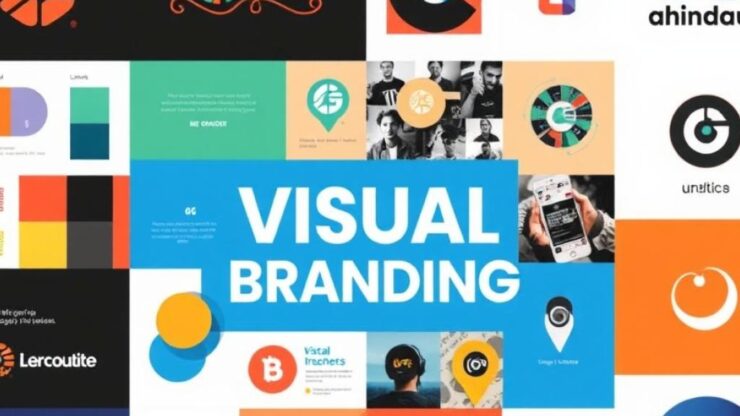Understanding Visual Branding Principles
The Essence of Visual Branding
In today’s digital landscape, visual branding has become an indispensable element in establishing a strong online presence. It encompasses the strategic use of imagery, color, typography, and design elements to create a cohesive identity that resonates with target audiences. Understanding these principles is crucial for freelancers engaged in social media content creation, as effective visual branding can significantly enhance brand recognition and customer engagement.
Key Components of Visual Branding
A successful visual branding strategy is built on several core components that work together to convey a brand’s message and values. Below is a comprehensive list of these essential elements:
- Logo Design: The logo serves as the face of the brand, embodying its identity and making a lasting impression.
- Color Palette: Colors evoke emotions and can influence consumer behavior; thus, a well-chosen palette is vital.
- Typography: The fonts used in branding communicate personality and tone, contributing to overall brand perception.
- Imagery: Consistent photographic style and graphic elements create visual harmony across platforms.
- Visual Hierarchy: The arrangement of elements guides viewer attention and enhances the effectiveness of the message.
Crafting a Cohesive Visual Identity
To create a unified visual identity, freelancers should ensure that all branding elements align with the brand’s core values and target audience preferences. This involves:
- Conducting Market Research: Understand the preferences and behaviors of the target demographic to tailor the visual identity accordingly.
- Creating a Brand Style Guide: Documenting guidelines for logo usage, color codes, typography, and imagery helps maintain consistency across all platforms.
- Regularly Updating Visual Content: Keeping visuals fresh and relevant to current trends while staying true to the brand’s essence can engage the audience effectively.
Crafting Engaging Multimedia Content

In the realm of freelance social media content creation, the ability to craft engaging multimedia content is paramount. As audiences increasingly gravitate towards visually rich experiences, freelancers must harness the power of various media formats to captivate and retain attention. This section explores the essential methodologies and strategies for producing compelling multimedia assets that not only complement but also amplify a brand’s messaging.
Leveraging Diverse Media Formats
Incorporating a variety of media formats can significantly enhance the engagement level of social media content. By blending images, videos, graphics, and animations, freelancers can create a dynamic storytelling experience that resonates with audiences. Understanding the strengths of each format is crucial for maximizing their impact:
- Images: High-quality images are vital for grabbing attention and conveying emotions quickly. They should align with the overall visual branding.
- Videos: Short, engaging videos can convey complex messages succinctly and are highly shareable, often leading to increased reach.
- Infographics: These visually appealing representations of data can simplify complex information and encourage shares, making them a powerful tool for education and engagement.
- Animations: Adding motion to graphics can make content more lively and memorable, often leading to higher retention rates.
Creating Interactive Experiences
Interactive content is another effective avenue for engaging audiences. By inviting users to participate, freelancers can foster a deeper connection with the brand. Here are some approaches to consider:
- Polls and Quizzes: These tools not only engage users but also provide valuable insights into audience preferences.
- Live Streams: Hosting live sessions allows for real-time interaction and fosters a sense of community among followers.
- Augmented Reality (AR): Utilizing AR can offer unique experiences that allow users to interact with the brand in innovative ways.
Evaluating and Refining Multimedia Strategies
The process of crafting multimedia content doesn’t end at creation; ongoing evaluation and refinement are crucial. Analyzing performance metrics helps freelancers understand what resonates with their audience. Key performance indicators (KPIs) to monitor include:
| Metric | Description | Importance |
|---|---|---|
| Engagement Rate | Measures likes, shares, and comments relative to reach. | Indicates audience interest and content effectiveness. |
| Click-Through Rate (CTR) | Percentage of users who click on a link in the content. | Reflects the success of call-to-action elements. |
| Conversion Rate | Percentage of users who complete a desired action (e.g., sign-up, purchase). | Measures content’s ability to drive business goals. |
Utilizing Design Tools for Impactful Posts
In the fast-paced world of freelance social media content creation, the use of design tools has emerged as a game-changer. These tools not only streamline the creative process but also empower freelancers to produce visually stunning posts that capture audience attention. Understanding how to leverage these design tools is essential for crafting impactful content that aligns with a brand’s visual identity.
Choosing the Right Design Software
Selecting the appropriate design software can significantly influence the quality of social media posts. Various programs cater to different skill levels and project requirements, making it crucial for freelancers to assess their needs before diving in. Below is a comparative analysis of popular design tools:
| Design Tool | Best For | Key Features |
|---|---|---|
| Canva | Beginners | User-friendly interface, extensive template library, and collaboration features. |
| Adobe Illustrator | Advanced designers | Vector graphics creation, high customization, and professional output quality. |
| Figma | Collaborative projects | Real-time collaboration, design systems, and interactive prototyping. |
| Photoshop | Image editing | Powerful photo editing tools, layer management, and text effects. |
Maximizing Visual Impact Through Design Features
Once the right design tool is selected, freelancers can focus on maximizing the impact of their posts through specific features and techniques. Understanding these elements can elevate content quality and effectiveness:
- Template Utilization: Templates provide a framework that ensures brand consistency while saving time.
- Custom Graphics: Original graphics can differentiate a brand and communicate its unique message.
- Color Theory: Applying color psychology can evoke desired emotional responses from the audience.
- Typography Selection: Choosing the right fonts can enhance readability and reinforce brand identity.
- Visual Storytelling: Combining text and visuals into a coherent story can enhance engagement and memorability.
Refining Content Through Feedback and Analytics
The design process does not end with the publication of content; continuous refinement is essential. Utilizing feedback and analytics can guide freelancers in optimizing their posts for better performance. Key metrics to consider include:
- Engagement Rate
- Audience Growth
- Shareability
By regularly analyzing these metrics, freelancers can identify what resonates with their audience and make informed adjustments to their design strategies.
Analyzing Audience Engagement Metrics
In the realm of freelance social media content creation, understanding audience engagement metrics is pivotal. These metrics provide valuable insights into how effectively your content resonates with the audience, enabling you to refine your strategies for maximum impact. By meticulously analyzing these metrics, freelancers can make data-driven decisions that enhance brand support and facilitate deeper connections with followers.
Deciphering Engagement Metrics
Engagement metrics encompass a variety of data points that reflect how users interact with your content. By interpreting these metrics accurately, freelancers can assess the effectiveness of their visual branding and content strategies. Here are some key engagement metrics to focus on:
- Engagement Rate: A critical indicator that measures the level of interaction (likes, shares, comments) relative to the total reach. A higher engagement rate signifies a content piece that resonates well with the audience.
- Click-Through Rate (CTR): This metric tracks the percentage of users who click on links within your content. It is essential for evaluating the success of your calls-to-action and the overall effectiveness of your content in driving traffic.
- Conversion Rate: This metric reveals the percentage of users who complete a desired action (such as signing up for a newsletter or making a purchase) after engaging with your content. It is a direct reflection of how well your content aligns with your business goals.
Leveraging Insights for Strategic Enhancements
Once the engagement metrics are deciphered, freelancers can leverage these insights to enhance their content strategies. Conducting regular reviews of engagement data allows for the identification of trends and preferences within the audience. Here are some strategies to consider:
- Content Adaptation: Use insights from engagement metrics to shift your content type or style. If video content shows higher engagement, consider incorporating more video formats into your strategy.
- Timing Optimization: Analyze when your audience is most active and schedule your posts accordingly to maximize visibility and interaction.
- Targeted Messaging: Utilize audience insights to tailor your messaging and visuals to better align with your audience’s interests and preferences, fostering a more personalized experience.
By adopting a proactive approach towards analyzing audience engagement metrics, freelancers can continuously refine their social media strategies, ensuring that their content not only supports the brand but also resonates deeply with the target audience.
Developing a Consistent Visual Style
In the competitive landscape of freelance social media content creation, developing a consistent visual style is not merely an aesthetic choice; it is a strategic necessity. A defined visual style not only enhances brand recognition but also fosters trust and loyalty among audiences. As freelancers navigate the intricacies of various platforms, establishing a cohesive visual style that aligns with a brand’s identity becomes crucial for effective communication and engagement.
Understanding the Elements of Visual Consistency is key to creating a visual style that resonates. This involves recognizing the significance of recurring elements such as color schemes, typography, and imagery. For instance, when a brand consistently uses a specific palette, it becomes instantly recognizable, allowing audiences to identify posts even before reading the text. Coupled with the right typography, which conveys the brand’s voice and personality, these elements work in harmony to create a memorable digital presence.
Moreover, imagery plays a pivotal role in establishing a visual style. Freelancers should strive for a consistent photographic or graphic approach that reflects the brand’s values and messaging. Whether opting for vibrant visuals or minimalist designs, the chosen style should resonate with the target audience. This consistency across all social media platforms not only enhances brand recall but also contributes to a professional image that can set a freelancer apart in a crowded marketplace.
Implementing a Visual Style Guide is a practical step towards maintaining this visual consistency. By documenting guidelines for logo usage, color specifications, and preferred typography, freelancers can ensure that all content adheres to the established visual framework. This guide serves as a reference point that minimizes discrepancies and promotes a unified brand image, making it easier for freelancers to produce content that aligns with the brand’s visual identity.
As the digital landscape continues to evolve, the importance of adapting visual styles to trends cannot be overlooked. While consistency is vital, flexibility allows brands to stay relevant and appealing to their audience. Freelancers should remain vigilant in analyzing emerging design trends and integrating them into their visual strategies without compromising the core brand identity.
Disclaimer
This article has been created or edited with the support of artificial intelligence and is for informational purposes only. The information provided should not be considered investment advice. Please seek the support of a professional advisor before making any investment decisions.






